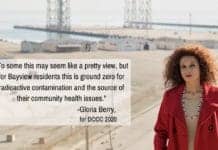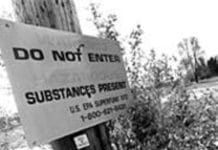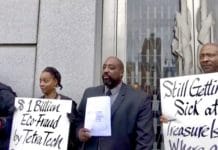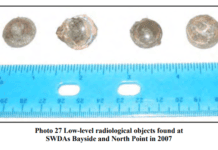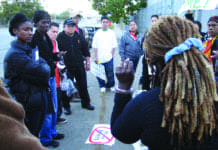
Parcel E-2 landfill, an EPA Superfund site, is a Pandora’s box that can’t be contained and must be removed
by Pete Palmer, Ph.D.
Remediation efforts at the Hunters Point Naval Shipyard have going on for many years, and it is highly likely that it may be many more years before this property is cleaned up and made available for open space, residential and industrial use. Nevertheless, recent news articles have discussed plans to speed up the pace of the cleanup and possible use of the Shipyard to house a new 49ers stadium. Many residents are concerned about environmental contamination on this site, how it will be remediated and potential effects that it might have on their health.
After more than 15 years of preliminary evaluations and investigations, the Navy released the first draft of its plans for remediating what is perhaps the most contaminated site in the Shipyard: Parcel E-2. Over a period from the 1940s through the 1960s, this site was created by placing fill materials and Shipyard wastes into the Bay in an area that formerly served as the drainage of Yosemite Creek. In the 1970s and 1980s, Triple A Machine Shop illegally disposed of additional industrial wastes on this site.
In 1989, the Shipyard was designated as an EPA Superfund site, starting a formal process that begins with investigating contamination on the site and ends with its eventual cleanup to appropriate standards consistent with the intended use.
It should be noted that all landfills are required to go through a review process prior to being reused for other purposes. Indeed, a former municipal landfill in the South Bay now houses Shoreline Amphitheatre, a golf course and open space for a variety of public uses.
However, municipal landfills are not allowed to be used for disposal of hazardous materials. Nevertheless, the Navy’s presentations at a Restoration Advisory Board meeting compared Parcel E-2 to municipal landfills. Clearly, this is not a valid comparison, as public records show that Parcel E-2 contains a wide variety of hazardous wastes, including radioactive wastes, polychlorinated biphenyls (PCBs) and toxic heavy metals.
The Navy’s draft remedial investigation and feasibility study (RI/FS) on Parcel E-2, which was released in March 2007, focused on two options for this site – excavation and disposal of the landfill contents or containment of the wastes. The proposed means of containment include a geotextile barrier and soil cap over the landfill and a barrier wall along the shoreline to prevent migration of contaminated water into the Bay.
The Community First Coalition, the state of California’s Department of Toxic Substances Control and the state’s Water Board recently submitted independent reviews of the Navy’s plans for this parcel in July. These evaluations were in agreement that the Navy’s RI/FS was incomplete in that it did not include radiological data and recommended that the Navy consider additional options for remediating this site.
While the Navy’s radiological addendum on Parcel E-2 is now months overdue and has still has not been submitted for public review, plenty of anecdotal information from past workers in the Shipyard attests to the potential problems this parcel will pose to future generations.
The landfill on Parcel E-2 was used for disposal of radioactive wastes over several decades. Some individuals have estimated that over 1,000 radium containing dials are buried in the landfill. Radiological wastes from the Naval Radiological Defense Laboratory were also disposed of in the landfill. Radium is a radioactive substance which has a half life of over 1,600 years, and the fact that the Navy disposed of radium containing wastes in a major urban location is in retrospect a serious and glaring mistake.
The Navy’s proposed plans to cap this landfill include measures to minimize and prevent exposure of the public and surrounding ecosystem to radioactive and other toxic wastes. It should be noted that these measures are neither permanent nor completely protective of the environment.

The geotextile barriers are intended to prevent groundwater from entering into the landfill and creating toxic runoff, but they do not prevent toxic gases from permeating to the outside atmosphere. Likewise, they have a finite lifetime and may be compromised and damaged by tree roots and burrowing animals. The barrier wall may indeed reduce migration of contaminated groundwater from the landfill into the San Francisco Bay, but the metal sheet pile barrier is readily corroded by saltwater and may not maintain its integrity in times of earthquakes, floods or a sea level rise caused by global warming.
San Francisco residents’ opinions on the future fate of the Shipyard are much clearer. In 2000, residents overwhelming approved Proposition P, which formally requested that the Navy clean up the Shipyard in a “manner that is fully protective of public health and the environment and does not rely on … barriers to protect future occupants and the public from exposure to pollution left by the Navy.”
While the Navy is obligated to consider the so called “presumptive remedy” of capping the landfill and containing these wastes as part of the Superfund site process, residents are rightfully concerned that the Navy not “walk away” from its obligations to return the Shipyard and Parcel E-2 in particular to an uncontaminated state.
Many community residents would like to see the pace of the remediation efforts quicken and the property returned to a pristine condition. But the sad reality is that these efforts are dependent on federal, EPA and Navy budgets and that the Navy’s estimates of the costs of capping this landfill are far cheaper than the complete excavation and removal of its contents.
It is hoped that the Navy and regulators overseeing this process will give higher priority to the long term health of San Franciscans and the environment over budgets and political expediencies and push for excavation and removal of contaminated soil in Parcel E-2. Only then can we be certain that the “Pandora’s box” of radiological wastes, PCBs and toxic heavy metals in Parcel E-2 will forever be removed as a possible source of harm to future residents and the surrounding ecosystem.
Pete Palmer, Ph.D., is associate chair of the Department of Chemistry and Biochemistry at San Francisco State University and the technical advisor to the Community First Coalition, a grassroots environmental justice organization in Bayview Hunters Point. Dr. Palmer is best known for analyzing the air samples brought back from the Soviet space station Mir before any Americans were allowed on board. He also analyzed air samples in Hunters Point in 1998. Contact him at rtomp@sbcglobal.net. This document has been partly supported through the use of EPA Technical Assistance Grant funds. Its contents do not necessarily reflect the policies, actions or positions of the EPA. Neither the Community First Coalition nor the author speak for or represent the EPA.

 Store
Store



